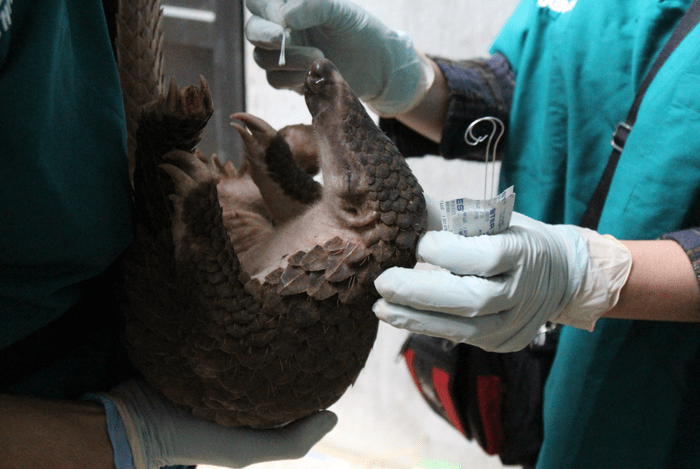A new study in the journal Frontiers in Public Health led by scientists from the Wildlife Conservation Society (WCS) confirms that pangolins confiscated from the illegal wildlife trade in Viet Nam host SARS-CoV-2 related coronaviruses. Previously, only pangolins confiscated in China had tested positive for SARS-CoV-2 related coronaviruses.
The authors of the study say that the findings are further evidence that the transnational nature of the wildlife trade can facilitate coronavirus and other viral transmission and amplification along the trade chain, providing further evidence that pandemic and epidemic prevention must also be focused on pathogen spillover from wildlife.
The study detected SARS-CoV-2 related coronaviruses, circulating in Sunda pangolins (Manis javanica) confiscated from the illegal wildlife trade in Viet Nam. Analysis revealed that the coronaviruses identified in these pangolins were closely related to coronaviruses previously detected in pangolins confiscated from the illegal wildlife trade in Yunnan and Guangxi provinces, China.
Said the study’s lead author, Nguyen Thi Thanh Nga of WCS’s Viet Nam Program: “We know that SARS-like coronaviruses (SARS-CoV-2 and SARS-CoV-1) can cause serious disease in humans. This study confirms the presence of coronaviruses in the SARS-CoV family in trafficked pangolins in Viet Nam. Eliminating the trade in pangolins and other wild mammals and birds will eliminate this high-risk pathway for viral spillover and pathogen emergence.”
All eight species of pangolins have been listed on CITES Appendix I since 2017, prohibiting all international trade for commercial purposes. All four species of Asian pangolins, including the Sunda and Chinese pangolin (Manis pentadactyla) are considered Endangered or Critically Endangered across their geographic range.
The authors of the study tested specimens from a total of 246 pangolins from wildlife confiscation events that occurred in Viet Nam in the years 2016 to 2018. Specimens collected from seven individual pangolins in 2018 tested positive for a SARS-CoV-2 related coronavirus.
In addition to testing pangolins for SARS-CoV-2 related coronaviruses, the authors reviewed media reports of pangolin trafficking cases involving Viet Nam between 2016 and 2020. Multiple pangolin confiscation events sampled in this study in Viet Nam involved other live wildlife including a mix of non-human primates, reptiles, and birds. These observations support long-held concerns that the live wildlife trade, moving wild animals out of their natural habitats and into human dominated landscapes and large urban centers, poses a serious and increasing risk of initiating epidemics from emergent pathogens in human populations.
These findings support current recommendations on regulation of live wildlife trade and markets, including the April 2021 Interim Guidance on ‘Reducing public health risks associated with the sale of live wild animals of mammalian species in traditional food markets’ issued by the WHO, United Nations Environmental Programme (UNEP), and the International Organisation for Animal Health (OIE), which called on governments to “Suspend the trade in live caught wild animals of mammalian species for food or breeding purposes and close sections of food markets selling live caught wild animals of mammalian species as an emergency measure unless demonstrable effective regulations and adequate risk assessments are in place.”
The authors also indicate that current international recommendations are too narrowly focused on open markets and do not address the much longer wildlife supply chains, trade of both legally and illegally sourced wildlife from its source. The authors indicate the need for wildlife trade policy reform to curb the risks of future pandemics and say mitigation measures must consider that the wildlife trade spillover interface contains novel viruses, which are not detected with current sample screening practices or procedures.
Among countries, China has initiated a multi-sectoral and sustained crackdown on illegal wildlife trade and legislative reforms designed to completely phase out the farming/sourcing, trade, and consumption of terrestrial wildlife as food. Viet Nam banned the importation of wildlife in January 2020, as an immediate response to the identification of SARS-CoV-2 in China, and called for its own heightened enforcement of existing laws on illegal wildlife trade as stipulated in the July 2020 Vietnamese Government Prime Minister’s Directive No. 29 on “urgent solutions to manage wildlife”. In the past two years, the Government of Viet Nam has revised a number of decrees addressing animal health, public health, food safety, and wildlife management with the aim of mitigating the risks and impacts of future pandemics. These include Decree 14 on regulating penalties for administrative offenses involving animal husbandry and Decree 07 issued in early 2022 which increased sanctions for violating wildlife trade laws and regulations.
WCS worked closely with local partners in Viet Nam to carry out this research. We would like to thank and acknowledge the contribution of our One Health partners from the animal health sector (Department of Animal Health, Regional Animal Health Office No. 6, Dong Nai Sub-Department of Livestock Production and Animal Health, Viet Nam National University of Agriculture) and from the wildlife and environmental protection sector (Cuc Phuong National Park, Save Viet Nam’s Wildlife, Dong Nai Province Forest Protection Department). This study was carried out as part of the United States Agency for International Development (USAID) Emerging Pandemic Threats PREDICT-2 project. The URL to the USAID Emerging Pandemic Threats Program (EPT-2) is https://www.usaid.gov/ept2. More information is available on WCS one health initiatives: https://oneworldonehealth.wcs.org/ and our work on coronaviruses: https://www.wcs.org/coronavirus.
###
WCS (Wildlife Conservation Society)
MISSION: WCS saves wildlife and wild places worldwide through science, conservation action, education, and inspiring people to value nature. To achieve our mission, WCS, based at the Bronx Zoo, harnesses the power of its Global Conservation Program in nearly 60 nations and in all the world’s oceans and its five wildlife parks in New York City, visited by 4 million people annually. WCS combines its expertise in the field, zoos, and aquarium to achieve its
Journal
Frontiers in Public Health
Method of Research
Meta-analysis
Subject of Research
Animals
Article Title
Evidence of SARS-CoV-2 related coronaviruses circulating in Sunda pangolins (Manis javanica) confiscated from the illegal wildlife trade in Viet Nam
Article Publication Date
9-Mar-2022
COI Statement
N/A
















































